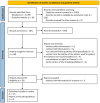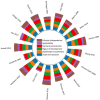Identifying complementary and alternative medicine recommendations for insomnia treatment and care: a systematic review and critical assessment of comprehensive clinical practice guidelines
- PMID: 37397764
- PMCID: PMC10308125
- DOI: 10.3389/fpubh.2023.1157419
Identifying complementary and alternative medicine recommendations for insomnia treatment and care: a systematic review and critical assessment of comprehensive clinical practice guidelines
Abstract
Background: There is a need for evidence-informed guidance on the use of complementary and alternative medicine (CAM) for insomnia because of its widespread utilization and a lack of guidance on the balance of benefits and harms. This systematic review aimed to identify and summarize the CAM recommendations associated with insomnia treatment and care from existing comprehensive clinical practice guidelines (CPGs). The quality of the eligible guidelines was appraised to assess the credibility of these recommendations.
Methods: Formally published CPGs incorporating CAM recommendations for insomnia management were searched for in seven databases from their inception to January 2023. The NCCIH website and six websites of international guideline developing institutions were also retrieved. The methodological and reporting quality of each included guideline was appraised using the AGREE II instrument and RIGHT statement, respectively.
Results: Seventeen eligible GCPs were included, and 14 were judged to be of moderate to high methodological and reporting quality. The reporting rate of eligible CPGs ranged from 42.9 to 97.1%. Twenty-two CAM modalities were implicated, involving nutritional or natural products, physical CAM, psychological CAM, homeopathy, aromatherapy, and mindful movements. Recommendations for these modalities were mostly unclear, unambiguous, uncertain, or conflicting. Logically explained graded recommendations supporting the CAM use in the treatment and/or care of insomnia were scarce, with bibliotherapy, Tai Chi, Yoga, and auriculotherapy positively recommended based on little and weak evidence. The only consensus was that four phytotherapeutics including valerian, chamomile, kava, and aromatherapy were not recommended for insomnia management because of risk profile and/or limited benefits.
Conclusions: Existing guidelines are generally limited in providing clear, evidence-informed recommendations for the use of CAM therapies for insomnia management due to a lack of high-quality evidence and multidisciplinary consultation in CPG development. More well-designed studies to provide reliable clinical evidence are therefore urgently needed. Allowing the engagement of a range of interdisciplinary stakeholders in future updates of CPGs is also warranted.
Systematic review registration: https://www.crd.york.ac.uk/prospero/display_record.php?RecordID=369155, identifier: CRD42022369155.
Keywords: CAM; clinical practice guidelines; complementary and alternative medicine; insomnia; photo therapeutics; quality assessment; sleep medicine; systematic review.
Copyright © 2023 Zhao, Xu, Kennedy, Conduit, Zhang, Wang, Fu and Zheng.
Conflict of interest statement
The authors declare that the research was conducted in the absence of any commercial or financial relationships that could be construed as a potential conflict of interest.
Figures





Similar articles
-
Identifying complementary and alternative medicine recommendations for anxiety treatment and care: a systematic review and critical assessment of comprehensive clinical practice guidelines.Front Psychiatry. 2023 Dec 12;14:1290580. doi: 10.3389/fpsyt.2023.1290580. eCollection 2023. Front Psychiatry. 2023. PMID: 38152358 Free PMC article.
-
A systematic review and quality assessment of complementary and alternative medicine recommendations in insomnia clinical practice guidelines.BMC Complement Med Ther. 2021 Feb 8;21(1):54. doi: 10.1186/s12906-021-03223-3. BMC Complement Med Ther. 2021. PMID: 33557810 Free PMC article.
-
Multiple sclerosis clinical practice guidelines provide few complementary and alternative medicine recommendations: A systematic review.Complement Ther Med. 2021 Jan;56:102595. doi: 10.1016/j.ctim.2020.102595. Epub 2020 Oct 18. Complement Ther Med. 2021. PMID: 33197670
-
Complementary and alternative medicine mention and recommendations in inflammatory bowel disease guidelines: systematic review and assessment using AGREE II.BMC Complement Med Ther. 2023 Jul 11;23(1):230. doi: 10.1186/s12906-023-04062-0. BMC Complement Med Ther. 2023. PMID: 37434218 Free PMC article.
-
Headache and migraine clinical practice guidelines: a systematic review and assessment of complementary and alternative medicine recommendations.BMC Complement Med Ther. 2021 Sep 22;21(1):236. doi: 10.1186/s12906-021-03401-3. BMC Complement Med Ther. 2021. PMID: 34551759 Free PMC article.
Cited by
-
Pregnant women's attitudes towards complementary and alternative medicine and the use of phytotherapy during the COVID-19 pandemic: A cross-sectional study.PLoS One. 2024 Jan 2;19(1):e0296435. doi: 10.1371/journal.pone.0296435. eCollection 2024. PLoS One. 2024. PMID: 38165916 Free PMC article.
-
Dietary Supplementation with an Extract of Aloysia citrodora (Lemon verbena) Improves Sleep Quality in Healthy Subjects: A Randomized Double-Blind Controlled Study.Nutrients. 2024 May 18;16(10):1523. doi: 10.3390/nu16101523. Nutrients. 2024. PMID: 38794761 Free PMC article. Clinical Trial.
-
Why some embrace and others hesitate? A behavioral analysis of insomnia sufferers' engagement with acupuncture treatment.World J Psychiatry. 2025 May 19;15(5):105802. doi: 10.5498/wjp.v15.i5.105802. eCollection 2025 May 19. World J Psychiatry. 2025. PMID: 40495850 Free PMC article.
-
Identifying complementary and alternative medicine recommendations for anxiety treatment and care: a systematic review and critical assessment of comprehensive clinical practice guidelines.Front Psychiatry. 2023 Dec 12;14:1290580. doi: 10.3389/fpsyt.2023.1290580. eCollection 2023. Front Psychiatry. 2023. PMID: 38152358 Free PMC article.
-
A cross-sectional study on the use of complementary and alternative medicine in insomnia patients referred to psychiatric clinics in Iran.Sleep Breath. 2025 May 22;29(3):192. doi: 10.1007/s11325-025-03354-8. Sleep Breath. 2025. PMID: 40402334
References
Publication types
MeSH terms
LinkOut - more resources
Full Text Sources
Medical

